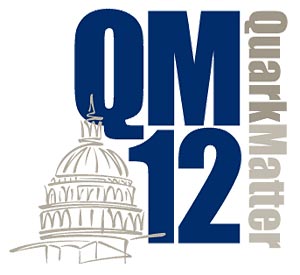MEDIA ADVISORY: Latest Findings on Primordial 'Soup' and Nature's Strongest Force
Physicists recreating conditions of early universe present new data at Quark Matter 2012
August 2, 2012

EVENT: Physicists from the Relativistic Heavy Ion Collider (RHIC), the only operating collider in the U.S., located at the U.S. Department of Energy’s Brookhaven National Laboratory, and the Large Hadron Collider (LHC), located at the European Organization for Nuclear Research (CERN), will present the latest results from their explorations of the primordial quark-gluon plasma that permeated the early universe at the Quark Matter 2012 conference in Washington, D.C.
WHEN: Sunday, August 12 – Saturday, August 18, 2012
PRESS BRIEFING: Monday, August 13, 2012, 1:15 p.m.
Overview of key findings from RHIC and LHC heavy-ion experiments, with an opportunity for Q&A with program and experiment scientists and nuclear physics theory experts. Congressional A
WHERE: Omni Shoreham Hotel, 2500 Calvert St. NW, Washington, D.C.
DETAILS: RHIC, a 2.4-mile-circumference particle accelerator that collides a range of heavy ions moving at nearly the speed of light, was the first machine to demonstrate the formation of quark-gluon plasma (QGP) — a nearly perfect liquid of strongly interacting quarks and gluons that filled the early universe before condensing to form protons, atoms, stars, planets, and everything else that makes up the visible universe today. The unexpected properties of this early-universe QGP have largely been confirmed by heavy-ion experiments at the LHC.* But many mysteries remain about the nature of the quark-gluon interactions that hold together our visible world and how they evolved from this primordial soup. The latest findings from RHIC and the LHC will enlighten our understanding and set the stage for future explorations.
Presentations from RHIC and LHC experiments will include:
- New details about the transition from ordinary matter to QGP
- Characteristics of ions before they collide, and effects on collision dynamics
- First results from new kinds of ion collisions, including football-shaped uranium ions and non-identical copper on gold
- Effects of the QGP on fast quarks and gluons (jet quenching)
- Suppression of heavy quark states by the QGP
HIGHLIGHTS: The following talks and events may be of special interest to reporters. Feel free to peruse the complete meeting timetable and attend other events.
Sunday, Aug. 12
9 a.m.-6:15 p.m. A series of talks and a reception for students and teachers as part of the Quark Matter community’s commitment to training the next generation of nuclear physicists. Palladian/Empire
Monday, Aug. 13
8:30 a.m. Welcoming remarks, including comments from Timothy Hallman, Associate Director for Nuclear Physics, U.S. Department of Energy’s (DOE) Office of Science, and Samuel Aronson, Director, Brookhaven National Laboratory. Regency 2/3
9:00 a.m. Keynote speaker: The Honorable Bart Gordon, former U.S. Representative from Tennessee and chair of House Committee on Science & Technology, 2007-2011. Regency 2/3
9:30 a.m. Broad overview of heavy-ion physics, Urs Wiedemann, CERN. Regency 2/3
10:45 a.m. – 12:50 p.m. Highlight talks from the RHIC and LHC heavy-ion experiments. Regency 2/3
- RHIC/PHENIX, Takao Sakaguchi, Brookhaven National Laboratory
- RHIC/STAR, Xin Dong, Lawrence Berkeley National Laboratory
- LHC/ALICE, Karel Safarik, CERN
- LHC/ATLAS, Barbara Krystyna Wosiek, Polish Academy of Sciences
- LHC/CMS, Gunther Roland, Massachusetts Institute of Technology
1:15 p.m. Press briefing: Overview of key findings/Q&A. Congressional A
7:30 p.m. Reception: An opportunity for informal interactions with physicists. Luce Center of the Smithsonian American Art Museum
Tuesday, Aug. 14
7:00 p.m. Public lecture: “Energy for the 21st Century World Economy: Problems and Opportunities,” Wolfgang Bauer, Distinguished University Professor, Michigan State University. Regency 2/3
Thursday, Aug. 16
7:30 p.m. Conference dinner, with an after-dinner talk starting at 8:45 p.m.: “Death From the Skies!” by Phil Plait, founder of BadAstronomy.com, a website dedicated to clearing up public misconceptions about science with a mix of humor and facts. Based on his 2008 book of the same name, the talk will discuss various “disaster scenarios” for humankind, including those that spring up with each new particle accelerator. Regency
Saturday, Aug. 18
8:30 a.m. Talks on the future of RHIC and heavy-ion experiments at the LHC. Regency 2/3
PRESS REGISTRATION: Reporters interested in attending any part of Quark Matter 2012 must register online. For reporters unable to attend in person, we will be webcasting the Monday morning talks and press briefing. To register for either or both webcasts, go to: http://www.aipwebcasting.com/reg-aug-2012.php. Reporters registered for the press briefing webcast will be able to email questions. For more information, contact Karen McNulty Walsh, Brookhaven Lab Media & Communications Office, 631 344-8350, kmcnulty@bnl.gov.
For additional background on quark matter physics, see The Exploration of Hot Nuclear Matter, a review article just published in Science, this press release, and a short video about research at RHIC.
*Heavy-ion physics at the LHC is a separate research program from the recently publicized search for the Higgs particle.
Research at RHIC is funded primarily by the DOE Office of Science, and also by these agencies and organizations.
DOE’s Office of Science is the single largest supporter of basic research in the physical sciences in the United States, and is working to address some of the most pressing challenges of our time. For more information, please visit science.energy.gov.
2012-11441 | INT/EXT | Newsroom









